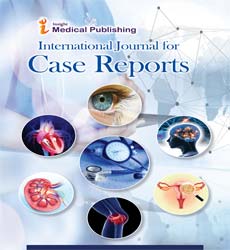Coronary Neovascularisation and Fistula in a Thrombus
Sharath Babu NM *, Anoop George Alex and Oommen K George
Department of Medicine, Indira Gandhi Medical College, Shimla, India
- *Corresponding Author:
- Sharath Babu NM
Department of Medicine
Indira Gandhi Medical College
Shimla, India
E-mail: nmsbabu18@yahoo.com
Received date: December 06, 2018; Accepted date: February 12, 2019; Published date: February 19, 2019
Copyright: ©2019 Sharath Babu NM, et al. This is an open-access article distributed under the terms of the Creative Commons Attribution License, which permits unrestricted use, distribution, and reproduction in any medium, provided the original author and source are credited.
Abstract
Coronary neovascularisation is a known phenomenon in cases of collateral formation. But the same entity has also been seen but less described in a chronic thrombus or tumors formed in atrial chambers. Here we present interesting images where neovascularisation with fistula formation was evident on angiography into a left atrial thrombus which was documented on echocardiography and also intraoperatively. This phenomenon might explain and avoid unusual anxiety when noted on angiography for the first time.
Keywords
Neovascularisation; Dyspnea; Tumor vascularity
Case Study
A 49-year-old woman presented with exertional dyspnea of NYHA class III and was diagnosed to be a case of rheumatic heart disease and was in atrial fibrillation. Her echocardiography showed severe mitral stenosis, pulmonary arterial hypertension and a non-homogeneous lesion in left atrial appendage of 19 mm×15 mm size suggestive of an organized thrombus (Figure 1). She was planned for surgical assessment followed by mitral valve replacement and a pre-operative coronary arteriography was done as per the protocol. Coronary arteriography showed codominant circulation with a coronary cameral fistula noted which fed the organized mass of left atrial appendage. The coronary cameral fistula was originating from left circumflex artery (Figures 2a and 2b). During surgery, presence of thrombus was confirmed which was removed and mitral valve replacement was performed.
Discussion
Coronary neovascularity and fistula formation was first described by Marshall et al in a tumor in 1965. Standen et al in 1975 described “tumor vascularity” as abnormal vessels arising from the left circumflex artery to the left atrium in a patient with severe mitral stenosis and later was found to be a thrombus [1]. The arteriographic findings of neovascularity and fistula formation from the coronary arteries to the left atrium have occasionally been reported in association with atrial thrombosis in patients with mitral valve disease. Colman et al. showed that the vessels supplying the thrombi were always observed to arise from the circumflex coronary artery and none had atherosclerotic coronary lesions. According to Colman et al, the coronary findings had a specificity of 98.8% and a sensitivity of 33% for the diagnosis of thrombus in left atrium [2]. In our patient also the thrombus was fed by left circumflex artery and echocardiography showed the thrombus. During surgery, it was confirmed as thrombus. Morgan et al. showed that correlation of left atrial mass on echocardiography to neovascularization on coronary arteriography is specific of thrombosis (99-100%) [3].
The mechanism of fistula and neovascularization is not clear. Standen suggested that the fistula formation in the left atrium resulted from partial necrosis of the organized thrombus with ulcerated surface, which allowed coronary blood to escape into the left atrial cavity [1]. But according to colman et al, there was no relation between coronary arteriography findings and the size and histologic age of the thrombi examined.
Conclusion
Correlation of left atrial mass on echocardiography to neovascularization on coronary arteriography is specific for thrombosis.
In majority of the cases the feeder vessels supplying the thrombus tends to originate from the left circumflex artery.
References
- Standen JR (1975) “Tumor Vascularity” in Left Atrial Thrombus Demonstrated by Selective Coronary Arteriography. Radiology 116: 549-550.
- Colman T, de Ubago JL, Figueroa A, Pomar JL, Gallo I, et al. (1981) Coronary arteriography and atrial thrombosis in mitral valve disease. Am J Cardiol 47: 973-977.
- Fu M, Hung JS, Lee CB, Cherng WJ, Chiang CW, et al. (1991) Coronary neovascularization as a specific sign for left atrial appendage thrombus in mitral stenosis. Am J Cardiol 67: 1158-1160.
Open Access Journals
- Aquaculture & Veterinary Science
- Chemistry & Chemical Sciences
- Clinical Sciences
- Engineering
- General Science
- Genetics & Molecular Biology
- Health Care & Nursing
- Immunology & Microbiology
- Materials Science
- Mathematics & Physics
- Medical Sciences
- Neurology & Psychiatry
- Oncology & Cancer Science
- Pharmaceutical Sciences


